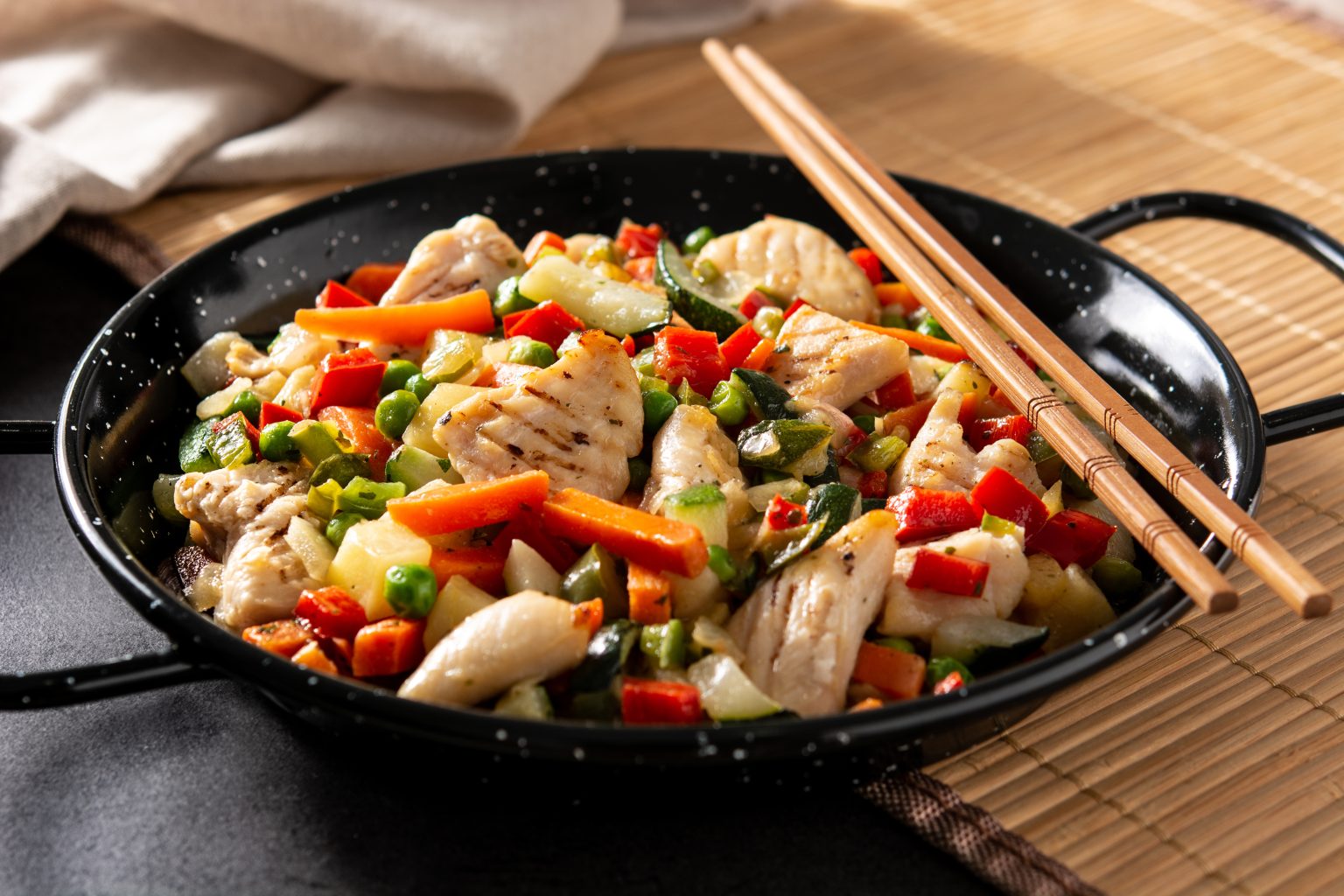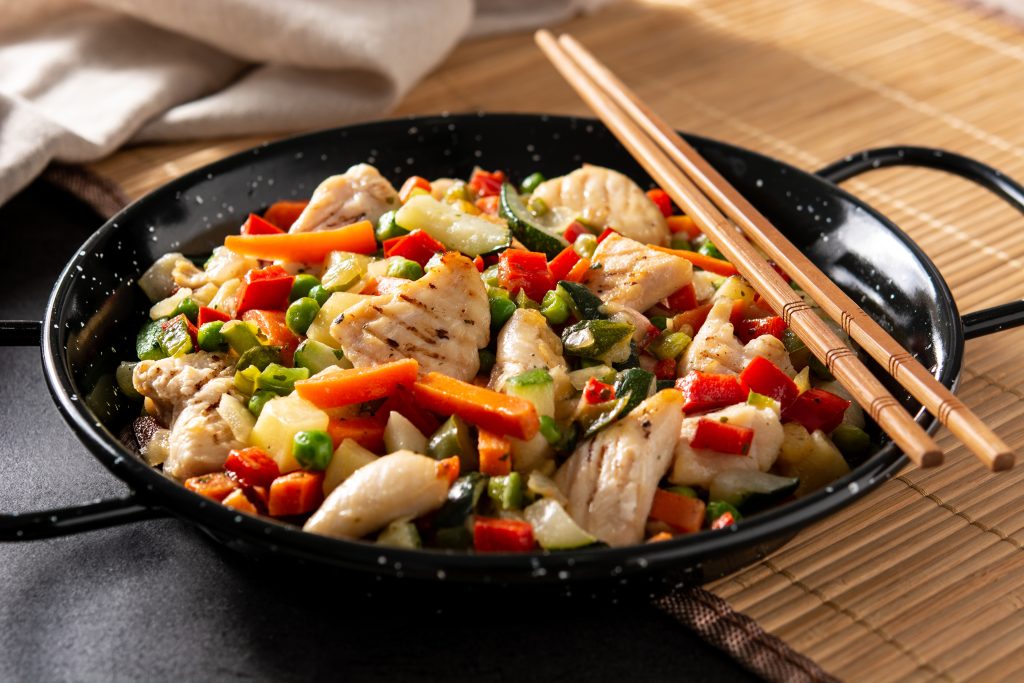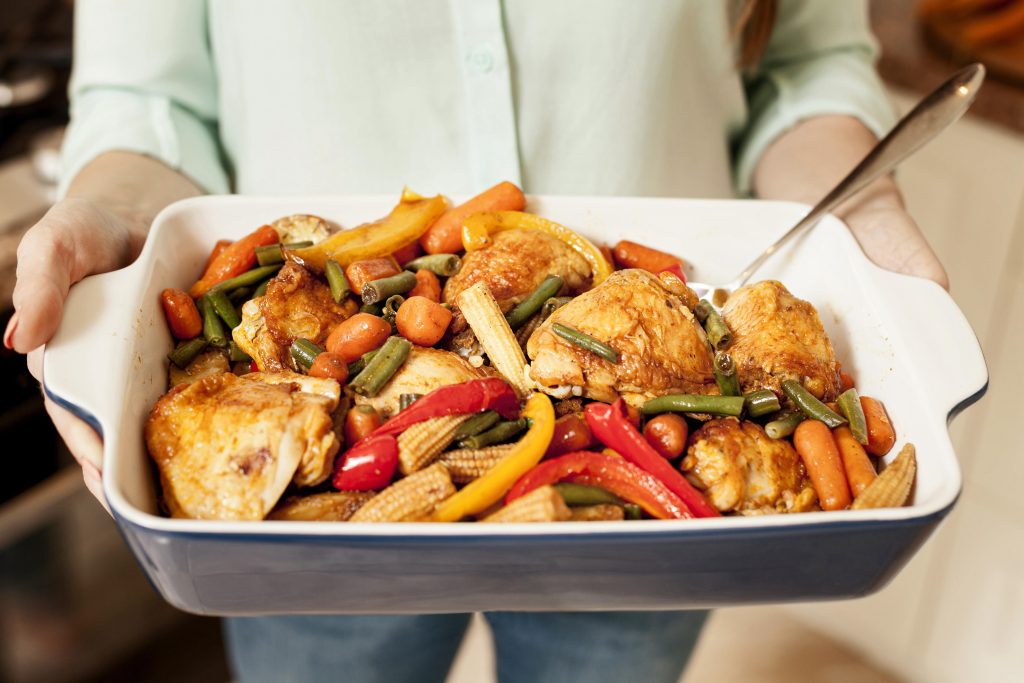Rotisserie chicken stir fry is not just a dish; it’s a delightful culinary experience. Originating from the bustling streets of Asian cities, stir fry dishes have become a global sensation. The fusion of juicy rotisserie chicken with crunchy vegetables, all drenched in a savory sauce, makes it a favorite for many. The added advantage? Using rotisserie chicken significantly cuts down the cooking time, making it a perfect choice for those busy weeknights. For those who love rotisserie chicken, exploring BBQ chicken rotisserie recipes can be another delightful culinary journey. The beauty of this dish lies in its adaptability. Whether you’re a spice lover or prefer milder flavors, there’s a version of rotisserie chicken stir fry for everyone.
Rotisserie Chicken Stir Fry Basics
Essential Ingredients for Chicken Stir Fry Recipe
Every great dish starts with great ingredients. For our rotisserie chicken stir fry, the stars of the show are:
- Rotisserie Chicken: The convenience and rich flavor it brings is unmatched. The chicken is already cooked to perfection, ensuring a tender and flavorful addition to the stir fry.
- Vegetables: Whether you opt for fresh or frozen, they add color, crunch, and nutrition. Popular choices include bell peppers, snap peas, broccoli, and carrots. The key is to choose vegetables that retain their crunch when stir-fried.
- Sauces: They are the heart of the dish, providing that perfect balance of flavors. The combination of sauces can be adjusted to cater to various palates, from sweet and tangy to spicy and savory.
Quick Chicken Stir Fry Sauce Recipe
A stir fry is only as good as its sauce. Our quick sauce packs a punch with just a few ingredients:
- Soy sauce: The salty depth. It’s the base for most stir fry sauces, providing a deep umami flavor.
- Sesame oil: For that authentic Asian flavor. A little goes a long way, and it adds a nutty aroma to the dish.
- Brown sugar: A hint of sweetness. It balances the saltiness of the soy sauce and adds a caramelized touch.
- Sriracha: For those who like a kick. It can be adjusted based on heat preference.
Remember, a good sauce is all about balance. Adjust the ingredients to suit your palate. For those on a specific diet, our low-carb rotisserie chicken recipes offer a variety of flavorful options.
Cooking Techniques
Cooking a stir fry is an art. Always start with a hot wok or skillet. This ensures a quick sear on the vegetables, retaining their crunch. Add the rotisserie chicken last to ensure it remains juicy and doesn’t dry out. The key is to keep the ingredients moving, ensuring even cooking and preventing any burns. If you’re looking for more ways to pair your rotisserie chicken, our ultimate pairing guide offers a plethora of options.
Techniques for the Perfect Rotisserie Chicken Skillet
Shortcuts and Time-Savers
We all love a good hack, especially if it saves time. Here are some for this dish:
- Pre-diced onions: No more teary eyes. While fresh onions provide a better crunch, pre-diced ones can save a lot of time.
- Garlic and ginger pastes: Flavor without the fuss. These pastes are readily available and can be a real time-saver.
- Pre-cooked rotisserie chicken: A major time-saver. It’s flavorful and can be added directly to the stir fry.
- Frozen stir-fry veggies: Just toss them in. They are pre-cut and often come in a mix of popular stir fry vegetables.
Optional Additions for Enhanced Flavor
Want to jazz up your stir fry? Here are some additions:
- Toasted sesame seeds: For a nutty crunch. They can be sprinkled on top for added texture.
- Sliced green onions: A burst of freshness. They add color and a mild onion flavor.
- Boiled rice or noodles: Makes it a complete meal. Choose from jasmine rice, brown rice, or even udon noodles.
Serving and Presentation Tips
A well-cooked dish deserves a good presentation. Garnish with some fresh herbs, serve it in a bowl, and watch it disappear in minutes! Using colorful vegetables can make the dish visually appealing. Serving it on a contrasting plate or bowl can make it pop. Always serve hot and with some extra sauce on the side for those who like it saucy.
FAQs
How to ensure the rotisserie chicken doesn’t dry out during stir frying?
One of the main concerns when using pre-cooked chicken is retaining its moisture. To ensure your rotisserie chicken doesn’t dry out:
- Add it last: Introducing the chicken towards the end of the cooking process ensures it gets heated through without overcooking.
- Stir gently: Over-stirring can break the chicken into smaller pieces, causing it to lose moisture faster. A gentle fold is all you need.
- Use a marinade or sauce: Before adding the chicken, toss it in a bit of the stir fry sauce. This not only flavors the chicken but also provides some moisture. For more on marinating techniques, check out this comprehensive guide on marinating chicken.
Can I use other meats or tofu instead of rotisserie chicken?
Absolutely! The beauty of stir fry is its adaptability. Depending on your dietary preferences or what’s available in your fridge, you can customize:
- Beef: Thinly sliced beef steak can be a great alternative. Ensure it’s marinated for a bit to tenderize.
- Shrimp: They cook quickly and add a seafood twist to the dish.
- Tofu:A favorite among vegetarians. Use firm tofu and consider marinating it for added flavor. If you’re new to tofu, here’s a beginner’s guide.
What other vegetables can be added to the stir fry?
The vegetable world is your oyster when it comes to stir fry. Apart from bell peppers, baby corn, and mushrooms, consider:
- Zucchini: Adds a different texture and absorbs flavors well.
- Snow peas: Crunchy and vibrant green, they’re a stir fry classic.
- Carrots: Thinly sliced or julienned, they add color and crunch.
- Bok choy: A leafy green that wilts beautifully in a stir fry. Learn more about how to cook with Bok choy.
How to store and reheat leftover rotisserie chicken stir fry?
Storing leftovers properly ensures they taste just as good the next day:
- Cool before storing: Allow your stir fry to come to room temperature to prevent condensation.
- Airtight containers: These are your best bet to prevent any moisture loss or contamination.
- Reheating: A skillet or pan on medium heat works best. Avoid microwaving as it can make the chicken rubbery. For more reheating tips, visit this useful guide.
Can I make the stir fry sauce in advance?
Yes, and it’s a great time-saver! Making your sauce in advance allows the flavors to meld. Store it in an airtight container in the refrigerator. Before using, give it a good shake or stir to ensure the ingredients haven’t separated.
Conclusion and Serving Suggestions
Rotisserie chicken stir fry stands out as a dish that combines convenience with gourmet flavors. Its versatility allows it to cater to various palates, from those who prefer the classic tastes to those who like to experiment.
Serving Suggestions:
- Rice: Whether it’s jasmine, basmati, or brown, rice complements the flavors of the stir fry. Consider making a fried rice on the side for an added twist. For rice enthusiasts, explore different rice varieties and their uses.
- Noodles: From ramen to udon or even spaghetti, noodles drenched in stir fry sauce are a delight.
- Salad: A light, crisp salad can balance the richness of the stir fry. Think cucumber salad or a tangy coleslaw.




1 thought on “Mastering Rotisserie Chicken Stir Fry: A Guide”